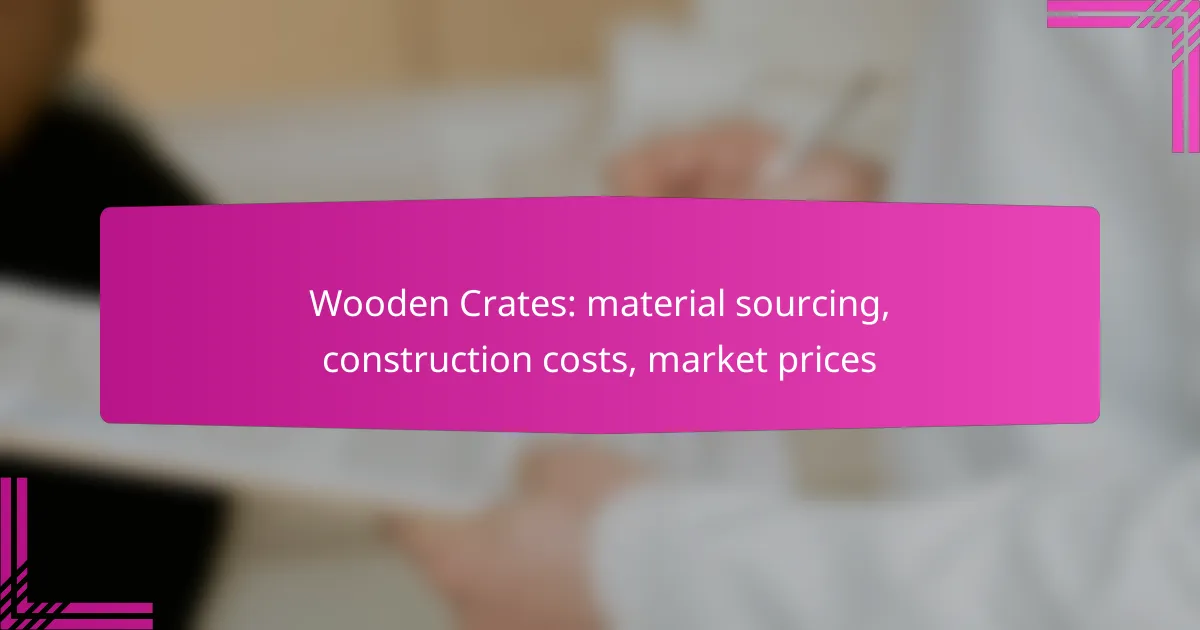Wooden crates are an essential product in New Zealand, with material sourcing options that include local timber suppliers and sustainable forestry practices. The construction costs can vary widely, influenced by factors such as materials and design complexity, while market prices typically range from NZD 10 to NZD 50 per unit, reflecting variations in size and quality. Understanding these elements is crucial for businesses looking to optimize their crate sourcing and budgeting strategies.

What are the material sourcing options for wooden crates in New Zealand?
In New Zealand, material sourcing options for wooden crates include local timber suppliers, sustainable forestry practices, and imported wood sources. Each option presents unique benefits and considerations regarding availability, cost, and environmental impact.
Local timber suppliers
Local timber suppliers in New Zealand provide a variety of wood species suitable for crate construction, such as pine and macrocarpa. Sourcing from local suppliers can reduce transportation costs and support the local economy.
When selecting a local supplier, consider factors like wood quality, pricing, and delivery times. Building relationships with reliable suppliers can also lead to better pricing and availability.
Sustainable forestry practices
Sustainable forestry practices are essential for ensuring a continuous supply of timber while minimizing environmental impact. In New Zealand, many suppliers adhere to certification standards like the Forest Stewardship Council (FSC), which guarantees responsible forest management.
Choosing timber from sustainably managed forests not only supports ecological balance but can also appeal to environmentally conscious consumers. Look for certifications when sourcing materials to ensure compliance with these practices.
Imported wood sources
Imported wood sources can offer a wider variety of species and potentially lower costs, but they may come with higher shipping expenses and longer lead times. Common imports include hardwoods from countries like Australia and the Pacific Islands.
When considering imported wood, evaluate the trade-offs between cost and sustainability. Ensure that the imported materials comply with New Zealand’s biosecurity regulations to prevent the introduction of pests and diseases.

What are the construction costs of wooden crates?
The construction costs of wooden crates can vary significantly based on materials, labor, and design complexity. Generally, these costs range from low tens to a few hundred dollars per crate, depending on factors such as size and wood quality.
Cost breakdown by material type
The primary materials used in wooden crate construction include softwoods like pine and hardwoods such as oak. Softwoods are typically more affordable, costing around 20-50% less than hardwoods, which offer greater durability but at a higher price point.
Additional costs may arise from treatments or finishes applied to the wood, which can enhance resistance to moisture and pests. These treatments can add 10-30% to the overall material cost, depending on the type used.
Labor costs in crate manufacturing
Labor costs in wooden crate manufacturing can vary based on location and the complexity of the design. In regions with higher wages, labor may account for 30-50% of the total construction cost.
Automated processes can reduce labor expenses, but initial investments in machinery can be significant. For small-scale operations, manual labor remains common, with costs typically ranging from $15 to $30 per hour.
Cost comparison with plastic crates
When comparing wooden crates to plastic crates, wooden options are often less expensive upfront but may require more maintenance over time. Plastic crates generally have a longer lifespan and can be reused extensively, which may justify their higher initial cost, often ranging from 50% to 100% more than wooden crates.
Additionally, plastic crates are usually lighter and easier to clean, making them preferable in certain industries. However, wooden crates are often favored for their aesthetic appeal and strength in heavy-duty applications.

What are the market prices for wooden crates in New Zealand?
The market prices for wooden crates in New Zealand typically range from NZD 10 to NZD 50 per unit, depending on size, material quality, and design. Factors such as sourcing, construction costs, and demand can significantly influence these prices.
Average price per crate size
The average price of wooden crates varies based on their dimensions. Small crates, suitable for personal use or small businesses, generally cost between NZD 10 and NZD 20. Medium-sized crates, often used for shipping or storage, range from NZD 20 to NZD 35, while large crates can go from NZD 35 to NZD 50 or more, depending on the specifications.
Factors influencing market prices
Market demand and supply dynamics also impact pricing. During peak seasons, such as harvest time, prices may rise due to increased demand from agricultural sectors. Conversely, during off-peak times, prices may stabilize or decrease.
Price trends over the last five years
Over the past five years, the prices of wooden crates in New Zealand have shown a gradual increase, attributed to rising material costs and heightened demand. The average price has grown by approximately 10-15% during this period.
Additionally, fluctuations in the global timber market have influenced local prices. As sustainability practices gain traction, eco-friendly wooden crates have become more popular, sometimes commanding higher prices due to their perceived value and sourcing practices.

What are the benefits of using wooden crates?
Wooden crates offer numerous advantages, including sustainability, strength, and versatility. They are widely used in various industries for packaging and transporting goods efficiently while minimizing environmental impact.
Eco-friendly packaging solution
Wooden crates are considered an eco-friendly packaging solution due to their renewable nature. Sourced from sustainably managed forests, they can be recycled or repurposed after use, reducing waste in landfills.
Additionally, wooden crates have a lower carbon footprint compared to plastic alternatives. They can decompose naturally, making them a preferable choice for environmentally conscious businesses.
Durability and strength
Wooden crates are known for their durability and strength, capable of withstanding heavy loads during transport. They provide excellent protection for fragile items, reducing the risk of damage during handling and shipping.
When properly constructed, wooden crates can last for multiple uses, making them a cost-effective option over time. Their robust design can accommodate various weights and sizes, catering to diverse shipping needs.
Customizability options
One of the key benefits of wooden crates is their customizability. Businesses can tailor the size, design, and features of crates to meet specific requirements, ensuring optimal protection for their products.
Options such as branding, additional reinforcements, and ventilation holes can be easily incorporated. This flexibility allows companies to create packaging solutions that align with their branding and logistical needs.

What are the challenges in sourcing wooden crates?
Sourcing wooden crates involves several challenges, including supply chain disruptions, regulatory compliance issues, and quality control concerns. These factors can significantly impact availability, cost, and the overall reliability of wooden crate supply.
Supply chain disruptions
Supply chain disruptions can arise from various factors, including natural disasters, transportation delays, and geopolitical tensions. For instance, a storm could affect timber harvesting, leading to shortages and increased prices.
To mitigate these risks, businesses should diversify their suppliers and maintain a buffer stock of crates. This strategy helps ensure continuity even when unexpected disruptions occur.
Regulatory compliance issues
Regulatory compliance is crucial in sourcing wooden crates, particularly regarding international shipping. Many countries have specific phytosanitary regulations that require wooden packaging to be treated to prevent pest infestations.
Companies must stay informed about these regulations to avoid fines or shipment delays. Regular training and updates on compliance standards can help ensure adherence to local and international laws.
Quality control concerns
Quality control is essential when sourcing wooden crates, as inconsistent quality can lead to product damage during transport. Factors such as wood type, treatment processes, and construction methods can affect the durability of crates.
Implementing strict quality assurance protocols, including regular inspections and testing, can help maintain high standards. Additionally, working with reputable suppliers known for their quality can reduce the risk of issues arising from poor craftsmanship.

What are the alternatives to wooden crates?
Alternatives to wooden crates include plastic crates, metal crates, and cardboard boxes. Each option has unique characteristics that may suit different needs based on durability, cost, and environmental considerations.
Plastic crates
Plastic crates are a popular alternative to wooden crates due to their lightweight nature and resistance to moisture and pests. They are often used in industries such as food and beverage, where hygiene is crucial.
When considering plastic crates, it’s essential to evaluate their load capacity and stackability. Many plastic crates can hold similar weights as wooden crates but may not be as strong in extreme conditions. Prices typically range from a few dollars to around twenty dollars per crate, depending on size and quality.
Be cautious of the environmental impact; while many plastic crates are recyclable, they may not decompose like wood. Opt for crates made from recycled materials to minimize ecological footprints.



